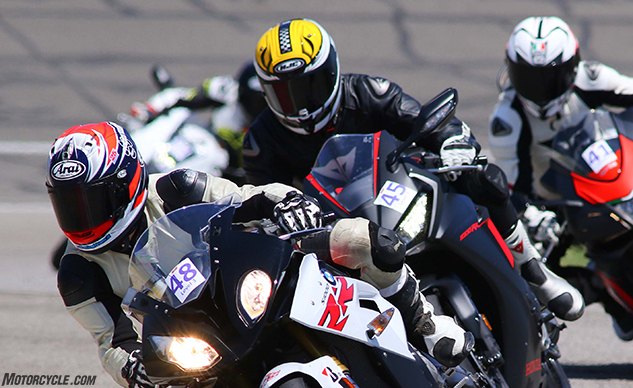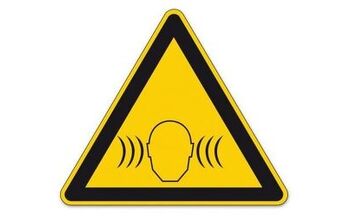Keeping Your Domepiece Safe: Best Motorcycle Racing Helmets

Going to the track? These are the helmets you should have on your head
Congratulations. You’ve made the decision to go to a trackday (or even a race). We think that’s one of the best decisions you can make with your motorcycle. Not only is track riding fun and addictive, but it’s also a great environment to improve your skills. But there’s a lot to do to get ready, like getting all your gear in order. Most important, of course, is your helmet.
Do you have a proper track helmet? Generally speaking, a good helmet for the track is full-face, with a double D-ring closure, that meets or exceeds all federal safety guidelines. You’ll have to consult with your local track or track/race organization for the specific helmet regulations they require, but the following selections are helmets we know will easily pass any tech inspection held anywhere in the US of A, and probably the rest of the world, too. A really good track helmet will have all of that, along with a bigger eye port that lets you see ahead when you’re prone on the gas tank, as aerodynamic and light a shell as possible, and great venting so you can keep a cool head.
There are many reputable helmet manufacturers out there, going about the task of head protection in their own unique ways, and there’s no way for us to sample all of them. But the helmets presented here all come from manufacturers we’d trust with our heads. Hours upon hours of time, money, and resources go into the science of making helmets as effective as possible – not just from an impact perspective, but lately, some manufacturers have poured resources into minimizing the effects of brain rotation during a crash as well. Those resources don’t come for free, however, so if you’ve wondered why top-shelf helmets cost so much, it’s because innovation has a price.
Table of Contents
Why Trust Motorcycle.com?
At Motorcycle.com, our reputation as a trusted authority in the motorcycle world since 1994 is built on our deep expertise and commitment to quality. Our team, composed of seasoned riders and industry experts, brings a wealth of knowledge and experience to every review and product recommendation we offer. We understand that when it comes to motorcycles, parts, and accessories, the right choice can enhance both performance and safety.
Our extensive range of in-depth reviews and performance tests are more than just evaluations; they are insights born from years of hands-on experience and a thorough understanding of what riders truly need. We cover every aspect of motorcycling, from sport bikes and cruisers to adventure bikes and beyond, ensuring that our recommendations cater to every type of rider.
The trust placed in us by over 2 million enthusiasts monthly is a testament to the reliability and accuracy of our advice. Whether it's selecting a new bike, finding the best accessories, or choosing the right gear for your ride, Motorcycle.com is dedicated to providing advice you can trust, backed by decades of expertise in the motorcycling field.
1. Editor's Pick: 6D ATS-1R
In our review of the 6D ATS-1R helmet, our editor embarked on a detailed exploration of its features, starting with an unexpected encounter at the WSBK weekend at Laguna Seca with Bob Weber, the CEO of 6D Helmets. This meeting led to the discovery of the latest iteration of the ATS-1 helmet, now upgraded and dubbed the ATS-1R. With an editor score of 92%, the helmet boasts high marks across aesthetics, protection, comfort, and innovation, including a perfect score in protection and innovation, highlighting its superior safety features.
The 6D ATS-1R introduces advancements in the Omni-Directional Suspension (ODS) system, a hallmark of 6D helmets, designed to enhance rotational brain injury protection through its unique dual-layer EPS construction. These improvements include a reduction in the number of isolation dampers from 29 to 10, contributing to a significant 200-gram weight reduction, making the helmet comparably light to other high-end models like those from Shoei and Arai.
Despite its larger outer shell size, the ATS-1R's innovative design facilitates exceptional ventilation and quietness, two features that our editor found particularly impressive. The helmet's ability to manage airflow efficiently, even in the hottest conditions, without sacrificing noise control, was a standout aspect of the experience. Furthermore, the ease of swapping visors and the snug, comfortable fit—despite an initial concern about sizing—were noted as highlights of the helmet's design and functionality.
Our editor's time with the ATS-1R revealed a helmet that excels in comfort for long rides, offers exceptional venting and quietness, and comes with premium features like a Pinlock visor and quick removal straps for the chin pads. Priced at $695 for solid colors and $745 for graphics, the 6D ATS-1R positions itself firmly in the premium helmet category, pushing the boundaries of head protection technology and offering riders a top-tier option that may well convert skeptics to fans.
2. AGV Pista GP R
In our comprehensive review of the AGV Pista GP-R, our editor delves into the intricacies that set this helmet apart in the realm of premium motorcycle gear, particularly for track use. With a starting price point of $1,400, extending up to $1,600 for race replicas, it's positioned as one of the priciest options available, only surpassed by Arai's Corsair X RC. This review aims to unpack whether the investment aligns with the value it offers.
The AGV Pista GP-R distinguishes itself with a full carbon fiber shell, contributing to its lightweight profile, and it stands out for providing a dedicated EPS liner for each of its four shell sizes, catering to seven helmet sizes from XS to XXL. This attention to size-specific design ensures optimal fit and weight distribution across different head sizes. The helmet's aerodynamics, enhanced by Computational Fluid Dynamic simulations and wind-tunnel testing, boasts a 4% improvement over its predecessor, the Pista GP. This is partly due to a dual-plane rear spoiler aimed at reducing turbulence and maintaining stability at high speeds, even when the rider turns their head.
The Pista GP-R's ventilation system is notable for its efficiency, channeling air through the helmet with five front vents and ensuring a comfortable experience even in rigorous conditions. Additionally, its visor offers an exceptional 190º horizontal and 85º vertical field of view, crucial for peripheral vision on the track. The visor is also equipped with a double anti-fog coating and a Pinlock 120 insert, covering the entire viewable area for clear visibility.
Riding impressions highlight the helmet's remarkably light weight and snug fit, designed explicitly for track and race use rather than everyday street riding. The helmet's aerodynamics provide excellent stability at speed, and despite its effective ventilation, it's noted for being quite loud, a trait for which AGV provides earplugs.
The visor's locking system is designed for safety, minimizing the risk of accidental openings during a crash. However, it lacks detents, offering only open, partially locked, or fully closed positions, which could lead to wear over time if frequently slammed shut. The Pista GP-R also includes a hydration system for convenience on the track, though its integration may be cumbersome for some users.
Ultimately, the AGV Pista GP-R is presented as a top-tier helmet for serious track enthusiasts, developed with input from Valentino Rossi and reflecting the highest standards of racing gear. Its design, materials, and features justify its premium status and price, offering advanced protection and performance for dedicated racers. As the Pista GP R transitions to the newer RR model, it remains a benchmark in the racing helmet category, embodying AGV's commitment to safety, comfort, and performance at the highest levels of motorcycle racing.
3. Arai Corsair-X
Arai's steadfast approach to helmet design is highlighted in our review of the Corsair-X, underscoring the brand's commitment to safety beyond standard certification requirements. Brian Weston, Arai's Managing Director, emphasized during the Corsair-X presentation that mere compliance with minimal standards doesn't fully address the unpredictable nature of motorcycle crashes. Arai's philosophy centers on exceeding these minimum requirements, focusing on comprehensive protection that accounts for various impact scenarios, not just those outlined by standard tests. This approach is indicative of Arai's commitment to safety as its paramount concern.
The Corsair-X's design features, including the R75 Shape principle, ensure that the helmet is as round as possible, minimizing the chances of the helmet catching on surfaces during a crash, thereby reducing rotational forces. This design ethos extends to the helmet's vents and diffusers, which are meant to "disappear" in an accident, further aligning with Arai's safety-first philosophy.
Arai's innovative use of a hard exterior shell, combined with a softer, multi-density foam liner, demonstrates a thoughtful approach to force distribution and absorption during impacts. This construction not only enhances the helmet's protective capabilities but also increases wearer comfort, a crucial factor during extended use. The Corsair-X also proudly incorporates features aimed at enhancing rider convenience and comfort, such as the VAS (Variable Axis System) for easier visor changes and a more intuitive shield locking mechanism inspired by Arai's Formula 1 helmet technology.
The track day testing of the Corsair-X at Thunder Hill Raceway provided practical insights into the helmet's performance, particularly highlighting its effective ventilation system, noise reduction efforts, and the overall stability at high speeds. The helmet's design facilitates a snug fit that becomes almost unnoticeable when riding, allowing the rider to focus entirely on the experience rather than being distracted by discomfort or instability.
Arai's Corsair-X not only adheres to the brand's long-standing commitment to safety and quality but also introduces meaningful innovations that reflect direct feedback from the riding community. While premium priced, the Corsair-X's meticulous design, safety features, and comfort enhancements justify the investment for serious riders who prioritize helmet performance and protection on both track and street.
In summary, the Corsair-X exemplifies Arai's philosophy of relentless refinement and a safety-above-all approach to helmet design. It is a testament to Arai's dedication to advancing helmet technology with rider safety and comfort at the forefront, reinforcing the brand's position as a leader in premium motorcycle helmet manufacturing.
FAQs
What to look for in motorcycle racing helmets?
The two primary things to look for in a racing helmet are:
- A DOT, SNELL, ECE, or FIM safety rating
- Proper fit
There’s a lot of controversy regarding the merit of different safety ratings, including DOT and SNELL, but those are topics for another discussion. If you plan on taking your motorcycle to the track, whether for racing or trackdays, one of these safety ratings on your helmet will be required (at least; check with the specific organization you plan to ride with for their requirements).
Even if you don’t plan on going to the track, safety ratings mean the helmet should provide a minimum level of safety should you land on your head. Decorative helmets (aka helmets without any sort of rating) are not tested to any standard and won’t protect you at all and are nothing more than, well, decoration.
A proper fit is important because no matter how many features and components a helmet has, if the helmet is uncomfortable on your head, you’re not going to wear it. The same goes for any piece of safety gear.
Are race car helmets the same as motorcycle race helmets?
No. There are several differences between car helmets and motorcycle helmets. For starters, motorcycle helmets tend to feature more robust ventilation channels since you’re exposed to the elements more so than even an open cockpit car. Eye ports on motorcycle helmets tend to be much larger as well. Some car helmets also have mounting points for neck restraints (HANS devices) that motorcycle helmets don’t.
A big difference between car helmets and motorcycle helmets is how each accounts for the dynamics that occur during a crash. In a car, the driver is strapped into the seat and there’s usually a roll bar and/or cage surrounding them. Because the driver’s position is basically fixed, their head/helmet will make impact with the same spot(s) continuously in a crash. So the helmet needs to be able to withstand those repeated hits (this is a big criterion in the SNELL test). Because a motorcycle rider gets ejected from the bike in a crash, it’s extremely unlikely the rider’s helmet will make impact with the same spot twice. If it does, it will be with a lot less force. The ECE rating takes into account rotational energy and dispersing impact forces as part of its certification process.
What helmet do motorcycle racers use?
All of the helmet companies you see above have professional racers wearing their helmets. While we can’t speak for every company, many of the helmets you see racers wearing are the exact same helmets you and I can buy on the shelf. Arai is a good example of this. Arai is proud to promote the fact the helmets you see on its professional racers are the same as the ones sold in stores – because it doesn’t matter who you are, head protection shouldn’t be biased.
Recent Updates
- March 29, 2024: For a better shopping evaluation, we have decided to reduce our list of recommendations to three. Also, we have updated our recommendations based on our editors' long-term testing and evaluations.
- September, 2021: FAQ, Additional Resources, and Recent Updates added, removed out of stock helmet.
Additional Resources
- MO Tested: 6D ATS-1R Helmet Review
- MO Tested: Arai Corsair-X Review
- MO Tested: AGV Pista GP R Review
- MO Tested: Bell Race Star Flex Helmet Review
- HJC RPHA 11 PRO Helmet Review
- MO Tested: Shoei X-Fourteen Review
- MO Tested: Shoei RF-1400 Helmet Review
- Best Motorcycle Racing Gloves
- Best Motorcycle Racing Tires You Can Also Use On The Street
We are committed to finding, researching, and recommending the best products. We earn commissions from purchases you make using the retail links in our product reviews. Learn more about how this works.
Become a Motorcycle.com insider. Get the latest motorcycle news first by subscribing to our newsletter here.

Troy's been riding motorcycles and writing about them since 2006, getting his start at Rider Magazine. From there, he moved to Sport Rider Magazine before finally landing at Motorcycle.com in 2011. A lifelong gearhead who didn't fully immerse himself in motorcycles until his teenage years, Troy's interests have always been in technology, performance, and going fast. Naturally, racing was the perfect avenue to combine all three. Troy has been racing nearly as long as he's been riding and has competed at the AMA national level. He's also won multiple club races throughout the country, culminating in a Utah Sport Bike Association championship in 2011. He has been invited as a guest instructor for the Yamaha Champions Riding School, and when he's not out riding, he's either wrenching on bikes or watching MotoGP.
More by Troy Siahaan



































Comments
Join the conversation
Nothing about which helmets are intended for which shape heads......? Not nearly helpful enough. For example, there isn't a higher end Shoei that fits my head properly, and there isn't a size Pista GP R that I can't easily pull off my head after it is firmly strapped on. Firm cheek pads aren't all that is necessary for a good fit.
Not one mention of a KYT helmet? Do you even know about the new KX-1 race-only FIM-approved helmet? KYT/Suomy are sister brands that have the same helmet. Have you been to a race lately or a trackway? Bang for the buck, they lead the way in safety, lightweight (2.5 pounds), exceptional peripheral viewing area, and most importantly, sub $1,000 price-points. The NZ Race runs $549-$650, has an incredible fit for American heads, and literally is one of the most comfortable helmets I have worn in my 55 years of riding. Take a peak at the starting grid of Moto GP, World Superbike, European championships, Moto America, and more. I am not writing just because of the KYT brand; you cannot discuss race helmets without including this. If you are really a fan of MotoGP, how many 6D helmets are on the grid? (I will let you answer this) I am not ripping 6D as the team over there work hard and have continually improved and redesigned their helmets to continually improve them, but your article is specifically titled "Best Motorcycle Racing Helmets". You did not include the Alpinestars Supertech R10? I'm not sure, but Jorge Martin seems to lead more than a few races in it, and again, it is one of the top racing helmets on the market today and a very serious racing helmet.
In this article, you seem to dismiss the ECE standard as a rotational energy and energy dispersing standard. It is the most stringent rating in the world now; nothing else comes close. 6D? are you kidding me? You have yet to consider the speeds at which race bikes are ridden, and the size and shape of the helmet are critical. Could you quote me how many more pounds of pull an Arai has to a Shoei X-Fourteen at 200 mph? I am pissed as I am sick and tired of poorly written articles that really do not dig into what matters to racers or street riders and what doesn't. I rarely speak up when I see poorly written articles, but this pushes my buttons. Every helmet should show whether it has singular or multiple safety ratings, helmet weights, and fit (oval, intermediate oval, round, etc. ). Eye-opening port (peripheral view) should have been measured, and the location of it assessed at a tuck and a high speed. The helmets should have been tested for poorly designed aerodynamics to ensure stability when coming out of a tuck and that it doesn't create a head shake. Airflow through the ventilation should be actually measured or calculated, with the number of vents mentioned. Shoei spends untold hours on what they call "Hot Head". Their thought process is a cooler temperature head, which allows a racer to think clearer at the end of a long, hot, tough race, and they engineer endlessly to ensure this happens.
Shield thickness matters as it pertains to sound reduction. Does the helmet come with Pinlocks and smoke shields included? Are they offered with tear-off pins in the shield for racers? Yes, I am hammering on this as I would like to see at least one "Helmet Comparison, including some scientific information, technical detail, a fundamental understanding of the design and engineering of a helmet down to the materials used in the shell, the resins used in the shell, the type of EPS or energy managing designs used, was it developed in a wind tunnel or not, what were the overall surface size of the helmet and expected pounds of pressure pulled on a riders head at speed. As a former racer, you should know what things should matter most to a racer, and as the writer of this article, it without question should have been researched more thoroughly as this feels mostly mailed in. You owe readers looking for more than a sales pitch better writing and research than this article provides.
Tim Calhoun
President
Powersports Pros Consulting